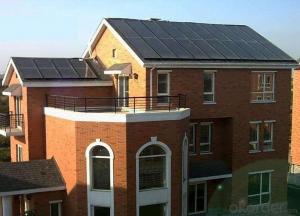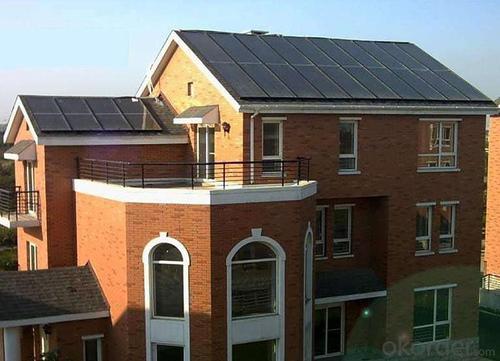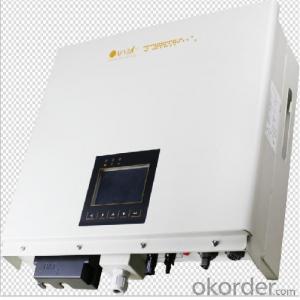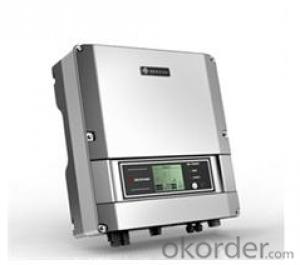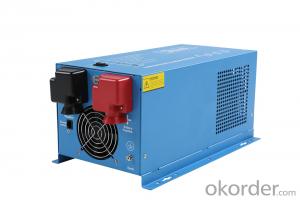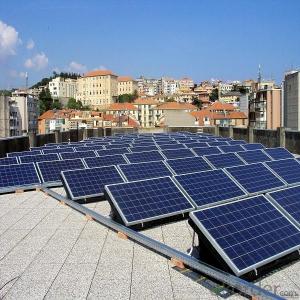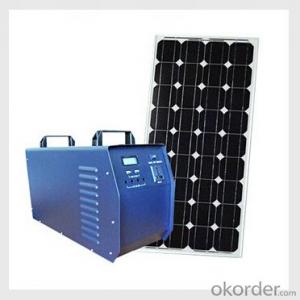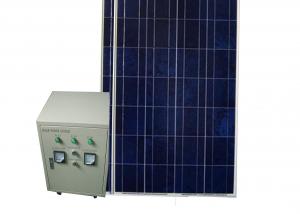Simmark Solar Energy Systems 20kw Solar Grid-Off Power System (3 Phase)
- Loading Port:
- China main port
- Payment Terms:
- TT OR LC
- Min Order Qty:
- 1 set
- Supply Capability:
- 500 set/month
OKorder Service Pledge
OKorder Financial Service
You Might Also Like
Specification
1.Technical parameters of 5kw Solar Off-grid Power System 20KW
- Solar panels
Power(Pmax): 300 Wp
Dimension: 1640x992x40 mm
Working Voltage(Voc): 39.7V
Working Current(Imp):9.32A
Weight: 20 kg
-PV Inverter with controller
Efficiency: >85%
Pure sine wave
AC 380V 50/60Hz output
Working Temp: 0℃~40℃
Battery overvoltage protection,undervoltage protection,overload protection,short circuit protection, overtemperature protection,etc.
650*570*1270mm 180KG
-Mounting Bracket
Flat roof or Ground: Galvanized steel type;
Tile roof: Aluminium type
Wind Load Resistanc: 45m/s
Snow Load: 2kN/m2
-GEL Battery of 12V 250Ah
520*269*228mm 64KG
-DC Cables
PV1-F
TUV/UL certificates
2. Product images

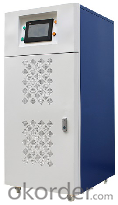
3. Product list
| No. | Item |
| 1 | Solar Panels |
| 2 | PV Inverter with controller built-in |
| 3 | Controller |
| 4 | Mounting racks |
| 5 | DC Cables |
| 6 | AC Cables |
| 7 | MC4 Connectors |
| 8 | GEL Battery |
| 9 | Combiner Box |
| 10 | Distribution box |
4. Remark
-In rainy days, the battery can support 3500W load work 24hours.
-The maximum power load should not exceed 18KW (including inductive load impact: such as refrigerators, air conditioners, washing machines, etc. with motor load).
-The battery can be fully charged in 5-6hours under STC sunshine condition.
5. Package
Wooden case or carton pallet packing


- Q: Can solar energy systems be installed on military bases or installations?
- Yes, solar energy systems can be installed on military bases or installations. In fact, many military bases across the world have already embraced solar power as a clean and sustainable energy source. These installations not only reduce reliance on traditional fossil fuels but also enhance energy security and resilience for critical operations. Additionally, solar energy systems on military bases can contribute to cost savings, environmental stewardship, and serve as an example for the broader community.
- Q: Can solar energy systems be used in powering art galleries or museums?
- Art galleries and museums can definitely utilize solar energy systems to power their establishments. In fact, there are numerous benefits associated with the use of solar power in these venues. Firstly, due to their large spaces and extensive lighting systems, art galleries and museums consume a significant amount of energy. By implementing solar energy systems, these establishments can generate a substantial amount of electricity, reducing their reliance on traditional energy sources and cutting down on operating expenses. Furthermore, incorporating solar energy aligns with the environmental values often associated with art and culture. By utilizing clean and renewable energy, art galleries and museums can greatly reduce their carbon footprint and contribute to global efforts in fighting climate change. Additionally, solar energy systems provide a reliable source of power, particularly during peak hours when galleries and museums experience a high influx of visitors. Moreover, the installation of solar panels on the rooftops of these establishments can serve as a visual representation of their commitment to sustainability, inspiring visitors to adopt similar practices in their own lives. However, it is important to consider that the feasibility of solar energy systems in art galleries or museums may vary depending on factors such as available roof space, geographical location, and specific energy requirements. Conducting a comprehensive assessment and feasibility study is vital to determine the optimal size and configuration of the solar energy system for each individual establishment. Overall, solar energy systems offer a clean, renewable, and cost-effective solution for powering art galleries and museums. Implementing these systems not only aligns their operations with sustainable practices but also reduces their environmental impact.
- Q: How do solar energy systems impact the aesthetics of a building?
- Solar energy systems can have a positive impact on the aesthetics of a building by providing a sleek and modern look, especially when integrated into the design. With advancements in technology, solar panels are becoming more visually appealing and can enhance the overall appearance of a building rather than detract from it. Additionally, solar energy systems can also contribute to a building's sustainability and eco-friendly image, improving its overall appeal.
- Q: Can a solar energy system be installed on a concrete roof?
- Yes, a solar energy system can be installed on a concrete roof. In fact, concrete roofs are one of the most ideal surfaces for solar panel installation. Concrete roofs are typically flat, stable, and durable, providing a solid foundation for the panels. Additionally, concrete roofs often have ample space and are not obstructed by nearby trees or buildings, allowing for maximum sunlight exposure. The installation process involves securing the panels to the concrete roof using special mounting systems designed to withstand the weight and ensure a secure attachment. Overall, concrete roofs are a great choice for solar energy system installation.
- Q: How do solar energy systems affect air pollution?
- Solar energy systems have a positive impact on air pollution as they produce electricity without emitting harmful pollutants or greenhouse gases. By replacing conventional fossil fuel-based power plants, solar energy systems help reduce air pollution and improve air quality, leading to a cleaner and healthier environment.
- Q: What is the impact of bird nesting on solar panel efficiency?
- Bird nesting can have a negative impact on solar panel efficiency. When birds build nests or leave droppings on the panels, it can block sunlight from reaching the surface, reducing the amount of energy the panels can generate. Additionally, bird nests can cause shading and create potential fire hazards if they contain flammable materials. Therefore, regular maintenance and preventive measures are necessary to ensure optimal solar panel efficiency.
- Q: What is the role of solar energy systems in promoting social equity?
- The promotion of social equity is one of the crucial roles played by solar energy systems. These systems create equal opportunities for individuals, regardless of their socioeconomic status. Solar energy offers several benefits, with one of the key advantages being its ability to lower energy costs for households and communities. By installing solar panels, individuals can generate their own clean and renewable energy, reducing their dependence on expensive fossil fuels and traditional energy sources. The reduction in energy costs is especially significant for low-income households, who often spend a higher proportion of their income on energy bills. Solar energy systems provide them with an opportunity to decrease their energy expenses, freeing up resources that can be allocated towards other essential needs like education, healthcare, or food. By alleviating the financial burden of energy costs, solar energy promotes social equity by helping to alleviate poverty and enhancing the overall quality of life for disadvantaged communities. Furthermore, solar energy systems contribute to the creation of green jobs and economic opportunities. The installation, maintenance, and operation of solar panels require a skilled workforce, offering employment opportunities for individuals in local communities. This can particularly benefit marginalized populations who may face obstacles to employment due to limited access to education or discrimination. By providing job opportunities in the renewable energy sector, solar energy systems contribute to reducing income inequality and promoting social mobility. Solar energy also has a positive impact on the environment and public health, which is crucial for promoting social equity. Traditional energy sources, like coal or natural gas, contribute to air pollution and climate change, disproportionately affecting low-income communities and communities of color. These communities often reside near power plants or industrial areas, resulting in higher rates of respiratory diseases and other health issues. By transitioning to solar energy systems, these communities can benefit from cleaner air and reduced pollution, leading to improved public health outcomes and a more equitable distribution of environmental benefits. Solar energy promotes social equity by addressing environmental injustices and ensuring that all individuals have equal access to clean and healthy environments. In conclusion, solar energy systems play a vital role in promoting social equity by reducing energy costs, creating job opportunities, improving public health, and addressing environmental injustices. By providing equal access to clean and affordable energy, solar power helps level the playing field and ensures that all individuals, regardless of their socioeconomic status, can enjoy the advantages of renewable energy.
- Q: Can solar energy systems be installed in areas with high wind speeds?
- Yes, solar energy systems can be installed in areas with high wind speeds. However, it is important to ensure that the solar panels and supporting structures are designed and installed to withstand the specific wind conditions in the area. This may involve using stronger materials, anchoring systems, or tilt mechanisms to minimize the risk of damage from high winds.
- Q: Can solar energy systems be used for powering food processing or packaging plants?
- Food processing or packaging plants can utilize solar energy systems to power their operations. These systems, like photovoltaic panels, generate electricity from sunlight. This electricity can then be used to operate machinery and processes in these plants. To function effectively, food processing and packaging plants require a significant amount of energy for various purposes, such as lighting, refrigeration, and machinery. By adopting solar energy, these plants can reduce their reliance on fossil fuels and decrease their carbon footprint. Installing solar energy systems on rooftops or nearby open spaces is possible for food processing or packaging plants. The energy produced by these systems can be used immediately or stored in batteries for later use. Additionally, surplus energy can be sold back to the power grid, creating an extra source of income. Although the initial cost of setting up solar energy systems can be high, the long-term advantages outweigh the expenses. Solar energy is a renewable and clean power source that decreases dependence on non-renewable resources and minimizes greenhouse gas emissions. Moreover, solar energy systems can be combined with energy-efficient technologies like LED lighting, energy management systems, and heat recovery systems to further enhance the overall efficiency of food processing or packaging plants. In conclusion, solar energy systems are a viable and sustainable option for powering food processing or packaging plants. They offer numerous benefits, including reduced operational costs, lower environmental impact, and increased energy independence.
- Q: Can solar energy systems be used for powering research laboratories?
- Yes, solar energy systems can definitely be used for powering research laboratories. Solar energy is a clean and renewable source of power that can be harnessed through photovoltaic (PV) panels or solar thermal systems. Research laboratories often require a significant amount of electricity to power various equipment, lighting, and ventilation systems, and solar energy can meet these energy demands effectively. Solar PV panels can be installed on the rooftop or open areas surrounding the laboratory to capture sunlight and convert it into electricity. This electricity can then be used to power the laboratory's infrastructure, including computers, microscopes, refrigeration units, and other specialized equipment. Additionally, excess electricity generated during the day can be stored in batteries or fed back into the grid for later use or to offset energy costs. Solar thermal systems, on the other hand, can be utilized to generate heat for laboratory processes that require heating, such as sterilization or chemical reactions. These systems use sunlight to heat a fluid, which can then be used directly or indirectly to provide heat to the laboratory. Implementing solar energy systems in research laboratories not only reduces the reliance on fossil fuels but also decreases greenhouse gas emissions and contributes to environmental sustainability. Moreover, it can lead to cost savings in the long term as solar energy is essentially free once the initial installation costs are recouped. However, it is important to consider the specific energy requirements of the research laboratory and conduct a comprehensive feasibility study before installing solar energy systems. Factors such as the laboratory's location, available sunlight, roof orientation, and space availability need to be taken into account to ensure optimal system performance. Additionally, the laboratory may need to have a backup power source or grid connection to ensure uninterrupted power supply during periods of low sunlight or high energy demand. Overall, solar energy systems are a viable and sustainable solution for powering research laboratories, providing clean and reliable energy to support scientific advancements.
Send your message to us
Simmark Solar Energy Systems 20kw Solar Grid-Off Power System (3 Phase)
- Loading Port:
- China main port
- Payment Terms:
- TT OR LC
- Min Order Qty:
- 1 set
- Supply Capability:
- 500 set/month
OKorder Service Pledge
OKorder Financial Service
Similar products
Hot products
Hot Searches
Related keywords
